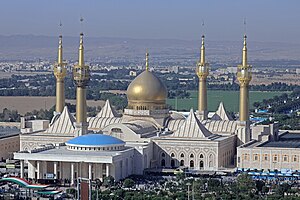Mausoleum of Ruhollah Khomeini
 | |
 | |
| 35°32′57″N 51°21′59″E / 35.5492°N 51.3665°E | |
| Location | Tehran, Iran |
|---|---|
| Designer | Parviz Moayyed |
| Type | Mausoleum |
| Beginning date | 19 July 1989 |
| Completion date | 2021 |
| Dedicated to | Ruhollah Khomeini |
| Website | www |
The mausoleum of Ruhollah Khomeini (Persian: آرامگاه روحالله خمینی) houses the tombs of Ayatollah Ruhollah Khomeini, his wife Khadijeh Saqafi, and his second son Ahmad Khomeini; and some political figures, such as former President Akbar Hashemi Rafsanjani,[1] former Vice President Hassan Habibi, Lieutenant General Ali Sayad Shirazi, Iranian Revolution figure Sadeq Tabatabaei, and MP Marzieh Hadidchi. The mausoleum is located to the south of Tehran in the Behesht-e Zahra (Paradise of Zahra) cemetery. Construction commenced in 1989 following Khomeini's death on June 3 of that year. It is still under construction, but when completed will be the centerpiece in a complex spread over 20 square kilometres (4,900 acres),[2] housing a cultural and tourist center, a university for Islamic studies, a seminary, a shopping mall, and a 20,000-car parking lot.[3][2] The Iranian government has reportedly devoted 2 billion US dollars to this development.[3]
The site is a place of pilgrimage for followers of Khomeini. It is used symbolically by government figures, and is on occasion visited by foreign dignitaries.[4] Every year, Khomeini's death anniversary is marked on 4 June at the mausoleum in a ceremony that is attended by governmental officials, foreign ambassadors, and others. Khomeini's grandson Ayatollah Seyyed Hassan Khomeini is in charge of caring for the mausoleum.[5]
Specifications
[edit]The architect of the tomb was Mohammed Tehrani.[2] The exterior of the shrine complex is a highly recognizable landmark. It has a gold dome sitting on a high drum, surrounded by four free-standing minarets.[6] The shrine is surrounded by a large rectangular plaza which has been designed to hold vast numbers of visitors. With its size, inclusion of a qibla wall and a maqsura, the tomb resembles a mosque, but has been called an Hussainia.[7]
Non-Muslims are allowed inside the complex.[8]



Incidents
[edit]On June 20, 2009, a suicide bomb attack occurred near the site of the Mausoleum, in which the attacker was killed and three pilgrims were injured, according to state media.[9]
On June 7, 2017, the mausoleum was attacked by three gunmen [10][11] while a suicide bomber detonated a bomb at the mausoleum.[12] One female militant attacker was captured.[13] Government officials later claimed to have thwarted a third attack.[12] One person died and five people were injured. Others attacked the parliament building at the same time.
References
[edit]- ^ "Holy Shrine of Imam Khomeini | Tehran, Iran | Attractions - Lonely Planet".
- ^ a b c Khomeini Tomb Archived 2009-06-26 at the Wayback Machine
- ^ a b Khomeini's Tomb Attracts Pilgrims - New York Times
- ^ FarsiNet News - News related to Iran, Iranians and Persians - June 1997
- ^ Khomeini's grandson speaks out on Iran military | France 24 Archived 2009-06-25 at the Wayback Machine
- ^ "Ayatollah Khomeini's mausoleum: A symbol of Iranian pride".
- ^ Kaplan, Robert, Ends of the Earth, A journey at the Dawn of the 21st Century, Random House, 1996, p.179
- ^ "Mehr-e-Khavar Iran In Brief". Archived from the original on 2009-06-25. Retrieved 2008-02-11.
- ^ "Bomber killed at Khomeini shrine - Iran media". Reuters. 2009-06-20. Retrieved 2021-07-24.
- ^ "7 killed in twin attacks on Iranian parliament and Khomeini's tomb, Hostage situation underway". Muslim Global. Retrieved 7 June 2017.
- ^ Iran Attacks: Shooting inside Iran's Parliament
- ^ a b "Iran attacks: 'IS' hits Parliament and Khomeini mausoleum". BBC. 7 June 2017. Retrieved 7 June 2017.
- ^ "Invasion four terrorist to Khomeini Shrine/ One woman was captured". fa.alalam.ir (in Persian). Retrieved 7 June 2017.
External links
[edit]- Ruhollah Khomeini
- Mausoleums in Iran
- Biographical museums in Iran
- Religious buildings and structures completed in 1992
- Buildings and structures in Tehran
- Museums in Tehran
- Religious buildings and structures in Tehran
- Monuments and memorials in Iran
- Tourist attractions in Tehran
- Islamic Republic of Iran era architecture
- 1992 establishments in Iran

















